Vickers Viscount Network
December 2008 Newsletter
Dear Member
WELCOME to this, the bumper December edition of the Vickers Viscount Network newsletter. In case
you did not notice - there weren't October and November 2008 editions. Just like anyone else, editors get sick,
have holidays and catch up on other things around the home.
In October/ November Editor Peter Layne of New Zealand visited England and took the opportunity to meet
the two website co-founders Brian Burrage and Geoff Blampied. It is universally accepted that
there is nothing like meeting people you regularly correspond with, in person. Naturally aeroplanes were a
popular choice of subject at meal times!
So much for the preamble, let's pick up where we left off in September.
AIRWORTHY VISCOUNT FOR SALE!
It all started with a request on the Key Publishing forum by The North Essex Transport Group,
England who are interested in acquiring the fuselage of a Vickers Viscount, the type of aircraft that once
operated from their location. They asked if anyone knew of anything that might be of interest to them? Is there
a fuselage that is dumped or abandoned at some airfield and is no longer needed? They are willing to consider
a complete airframe and have the space to display it inside a disused hangar.
On the 11 November 2008 Di Cambio posted this:-
'We got one! In a flyable condition on top of that. One of the last flying on the planet earth. My company
named Global Airways is currently selling it. After several years of loyal services, we can't cope with
its gigantic consumption, that is why we are looking for a much fuel saver turbo prop.'
'If The North Essex Transport Group are still interested in acquiring a Vickers Viscount fuselage, parts and
much more, please advise so we can discuss.'
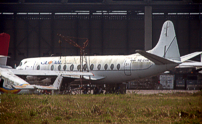
Global Airways Viscount c/n 382
9Q-CON taken 2 March 2008.
Viscount c/n 382 was originally built for BEA - British European Airways as G-APEY and as 9Q-CON is currently
stored in the Democratic Republic of the Congo.
To follow the progress of this project have a look at the posting on the Key Publishing forum:-
http://forum.keypublishing.co.uk/showthread.php?t=84973
You will see that there is a lot of interest and it would be great to get more Viscounts preserved.
Vickers Viscount Network co-founder Geoff Blampied says 'Since the network was started in 2005,
we have had many people contact us saying how they miss the unique sight and sound of the Viscount with its
four Rolls-Royce Dart engines in flight, and wouldn't it be great to have one in the air once again.'
'There is a Viscount in America that is close to being airworthy and the MAAM - Mid Atlantic Air
Museum tells us that all they need is a new Rolls-Royce Dart to get it finished. Watch our pages for
progress with this project.'
'However, Europe is far from this position with no aircraft being prepared for flight. Perhaps the sale
of the Global Airways Viscount could be the catalyst to correct this situation. It would be a mammoth task. A
task that would need a special type of leadership. Leadership that could set-up a trust to finance the project,
both for the restoration and to keep the project flying afterwards, to find and organise the engineering and
aviation regulation requirements, to find and train air and maintenance crews. In all, this would be a very big
task but one that would bring back and promote the memory of this pioneering aircraft.'
'The Vickers Viscount Network would love to get involved with a project of this nature to act as the
window to the world to bring all interested parties together, and to keep the world of Viscount supporters
informed on the progress being made. If you feel that you are this person then please get in-touch. Other
aviation groups have succeeded with one even getting an Avro Vulcan back into the air!'
GOOD NEWS
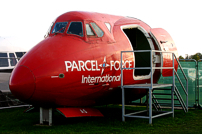
Viscount c/n 263 G-OPAS after it was moved in 2008.
As previously reported, at the end of 2007 the Bournemouth Aviation Museum closed due to airport
expansion plans and a dark cloud hung over the larger aircraft.
Happily, on October 24 2008 they re-opened on a new site and amongst the exhibits transferred across was the
nose section of Viscount c/n 263 G-OPAS in the smart red Parcel Force livery.
. . . AND IN SOUTH AFRICA
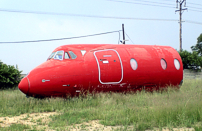
Viscount c/n 265 G-PFBT
in South Africa.
G-OPAS's sister Viscount c/n 265 G-PFBT was noted by Bill Greenwood in a builder's yard at Kya Sand
industrial Estate, Randburg, South Africa late 2008. The starboard side of the fuselage has been painted in a
hideous pschycedelic colour scheme.
BAD NEWS
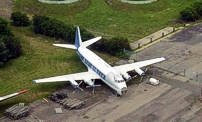
Ex flying test bed Viscount
c/n 384 C-FTID-X is looking
for a new home.
We have been notified by J E Laframboise of the Fondation Aerovision Quebec that C-FTID-X is now
in mortal danger, as it has to be moved from its current position at St Hubert and there is nowhere for it to
go. This aircraft was made famous as the United Technologies / Pratt and Whitney Canada flying testbed, with
various turboprops fitted to its nose for in-flight evaluation purposes. They are reluctant to scrap it for
the $0.25 per pound that they would receive and have enlisted our help in trying to find a new home for her.
Any takers?
MYSTERIES SOLVED
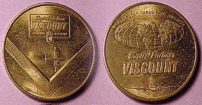
Capital Airlines Viscount token.
Bill Lukens (ex Capital Airlines) has supplied the following concerning the buttons mentioned
in the September Newsletter.
The Capital Airline 'button' was used to demonstrate the smoothness and lack of vibration of the
Viscount by balancing the coin on edge on the tray table while in flight. In smooth air the coin would stay
on edge for a considerable amount of time.
HELP REQUIRED
Are you a problem solver? Would you like to test your skills at research? Then look no further than our
'Mystery' page and help us identify these Viscounts by selecting on our site [Listings] and [Help us
Identify these Viscounts]. From time to time we receive photos of aircraft that we cannot identify. These
important images often point to a missing part of Viscount histories and need to be solved.
CAMOUFLAGED INDIAN AIRLINES VISCOUNTS
IDENTITIES PLEASE
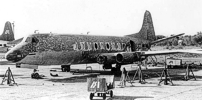
Camouflaged Indian Airlines Viscount marked as 'No 1'.
Here's one for the followers of Indian registered Viscounts to pursue.
Peter Upton recently contacted the Indian Air Force with regard to photographs dated about March
1972 that have come to light depicting Indian Airline Viscounts wearing camouflage. Air Force spokesman
Jagan Pillarisetti concurs with the timing noting that India and Pakistan were at war with each other in
December 1971. Jagan has offered to investigate the civilian identities but is there someone out there who
already knows these details? If so, please let us know. Jagan reports under website
www.bharat-rakshak.com. Check it out when you get a chance.
SOAF - SULTAN OF OMAN'S AIR FORCE VISCOUNT QUERY
Mike Burrett asks:
'I used to spend time at Hurn, Bournemouth, England in the late 60s early 70s and watched Channel Airways
Viscounts come and go but every now and then a Viscount from the Sultan of Oman's Air Force used to come
in. It had 501 on the side and extra fuel pods built into the wings. Dark-suited men filed off. Just wondered
what aircraft it was and did the SOAF operate other Viscounts?'
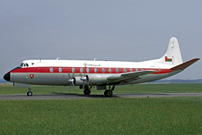
SOAF - Sultan of Oman's Air Force Viscount 501.
Vickers Viscount Network co-founder Brian Burrage says that the Sultan of Oman's Air Force
had several Viscounts and to see all the information we currently have on SOAF Viscounts have a look at pages
[Listings] [Aircraft histories]. Click on the [Registration] down arrow and you will find 501,
502, 504 (two different aircraft), 505 and 506. Select anyone of these and click [Go] and you will be
taken to the complete history of the aircraft selected.
Have a look through these pages - the information may surprise you. As with all the histories on our site,
there is much information still to be gathered. If you can fill any gaps then please get in touch, we will be
most appreciative. This subject is very large and when you consider the long life span of the Viscount we feel
that it is most unlikely that will ever completely finish our task, but we hope to get close.
VISCOUNT NOT WANTED!
Kent Davis, a retired Air Canada captain, has asked if we are interested in an episode back in the
mid 1970s when he visited Air Canada's Maintenance section in Winnipeg. What he has to say is exactly what
interests the Vickers Viscount Network - you won't find this information in any book. He reports:
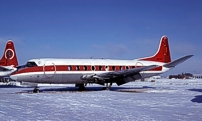
Beaver Enterprises Viscount
c/n 274 CF-THN.
'One day I went in and asked what they were going to do with those Viscounts. I was told that they had all been
sold to a company in Montreal called Beaver Enterprises. I got the phone number and called them to let
them know that I had a small aircraft ferry business and if they needed them moved or flown for any reason, we
could help.
The next day I received a call asking me to do a test flight for a company that was sending a rep to Winnipeg
with the idea of purchasing one or more of the aircraft. I met with them the next day. They were from Ecuador
and we scheduled a test flight for the next day. They operated into very high strips in the mountains and wanted
to see a go around executed at 17,000 ft. Air Canada's aircraft were the 700 series and were under powered for
this type of work. The go around was executed at exactly 17,000 ft and the aircraft levelled off at 15,000 ft.
That was the end of the flight. No sale.
My company then moved quite a few of the aircraft to different parts of the world. The aircraft were designated
'A', 'B' and 'C' aircraft. 'A' were to be completely overhauled and sold, 'B' were to be sold as is or the
customer would pay for overhaul, and 'C' were to be taken to Cartierville Airport outside Montreal and scrapped.'
VISCOUNT PART NUMBER SYSTEM
Kelvin Osborne has this to offer regarding the part numbering system. He says, 'from memory the aircraft
numbering runs like this: 701, 724, 802 and was the number allocated to a particular customers aircraft, 701
was the first production type Viscount for BEA - British European Airways, 724 was built for TCA -
Trans-Canada Air Lines, and 802 was the first 800 Series Viscount built for BEA -British European
Airways.'
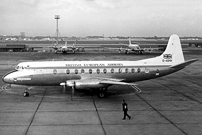
BEA - British European Airways
V.802 Viscount c/n 157 G-AOHH.
'The various assemblies would have the next two numbers allocated, fuselage was 01 and wings 03. I know 03 as
Saunders-Roe built wing sets i.e. 74503 were the wings for the Capital Airlines V.745 Viscounts.'
'The individual parts were numbered in sequence, I seem to recall the top and bottom spar tee sections would
have been -001 and -002. Thus the Capital Airlines units were numbered 74503-001 and 74503-002.'
'I guess the numbers in question from the request from Denys Jones as areas - ***82 plus were relating
to that area of the whole aircraft assembly.'
MEMBERS' CORNER - SHARE YOUR EXPERIENCE
Many of us have at the back of our mind experiences which trigger a life-long interest in aircraft, or a
particular type of aircraft, or even an individual aircraft.
This story from Mike L from Montreal, Canada is very much along those lines:
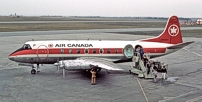
Air Canada Viscount
c/n 223 CF-THF.
'I was 11 years old, and had never flown on an airplane but lusted to do so like most red-blooded kids my age.
My father, that summer, took a day off and took me from Montreal to Ottawa by plane. We flew out on a Vickers
Viscount (that should date me!) and back on a DC-9, so I could experience both a prop and a jet.
On the flight out, on the Viscount, I was glued to the huge oval window looking at the view below and vaguely
noticed my Dad talking to the stewardess (proper terminology for the times!), but didn't pay attention until
she returned, and said 'OK', and my Dad said 'follow her!'. Which I did, which brought me into the cockpit, and
thus started a kid's life-long love affair with aviation.
Sadly, my dad died of a stroke two years later, and to this day, 37 years later, I still miss him greatly. I
never did get to be an airline pilot, but I do own and fly my own airplane!
. . . and from Colin Carr
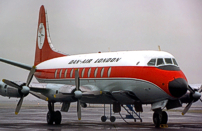
Dan-Air London Viscount
c/n 36 G-ARIR.
'One Sunday afternoon in 1978, 13th August to be exact, I was working in Alidair operations at East
Midlands Airport. The main flight to watch that day was a Dan-Air London service operated by, if memory
serves me right, Viscount V.708 G-ARIR on a wet lease. It was working its way from Glasgow via the Isle of Man
and Bristol to Jersey before finishing the day at Lydd. From there it would spend the week operating Lydd -
Beauvais Skycoach services.'
'All was going well until near the end of my shift. Then I had a phone call from the Captain, 'Jeep'
Holmes in the Isle of Man. They could not start one of the engines, apparently because of a starter motor
failure. Fortunately 'Jeep' was a very pro-active sort of captain. After off-loading the passengers, he
proposed to do a three engine take-off. This was legal because the airfield has a 6,000 ft runway. Once
airborne, the crew unfeathered the dead engine which then windmilled, fuel and igniters then fired it up and we
had a four engined Viscount again. He landed back at IOM, kept the re-lit engine running, boarded the
passengers once more, and took off for Bristol.'
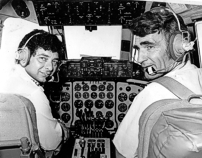
On the right is Alidair training
Captain 'Jeep' Holmes who flew
Hurricats during World War II.
'By that time, my shift was over. I had organised a Piper Aztec (G-BBEY) charter to take an engineer to
Bristol which was the Viscount's next scheduled stop. I was somewhat miffed that the engineer was late arriving
with his tools (and his family!) for the flight to Bristol. As a result, we (I had also gone along for the
ride!) arrived there after the Viscount, and 'Jeep' was ready to give me some hassle over this, until I
explained that the engineer had gone irretrievably into 'family Sunday afternoon out' mode instead of focusing
on the job in hand.'
'It only took about forty minutes to rectify the starter problem. We watched the aircraft start up and depart
for Jersey, and then it was time to go home to East Midlands.'
NOTE; A Hurricat was a marine version of the Hawker Hurricane and was used to protect Atlantic convoys.
Jack Stephens is a firmer believer in 'getting it down'. Sure that applies to aircraft but in the
historic sense it means to 'get it recorded'. He is one of those who recognise that today's news is tomorrow's
history. We will be running more of Jack contributions - partly for your interest and partly to provide an
incentive for others to recall and share their Viscount memories. Don't be too concerned about grammar or lack
of photos. Obviously, if you can get it right and supply supporting photos then that will certainly help.
Jack sent in the last part of Aircraft Inspector, Ray Sirrinen's story 'The Viscount Years and The
Winnipeg Spirit'.
Remember the busted spar cleats and something called trailing edge 'false work'? How many times did we have to
repair or change those auxiliary gear box drip trays, and then the best repair came in a bottle - fibreglass? Then
there were always special inspections or campaigns that the teletype machine would spring on us about Friday at noon.
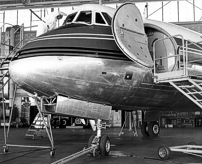
TCA - Trans-Canada Air Lines
Viscount CF-TGT in the
Winnipeg maintenance hangar.
'Impossible', we said when they told us we had to x-ray the complete belly skin for corrosion. The biggest
thing we had x-rayed prior to that was a tire bead. We learned fast.
The scrap pile was like a rubber mountain. The electricians will long remember the aluminium wires and their
terminals and the 'earth' bondings. Then there were the mysteries of spill valves, outflow valves, chock heat
valves and corrector motors with datums all sent to try us. The Viscount wing has 20 individual rubber fuel
cells. Each has been known to cause leaks. Tracing and repairing the offender is enough to make a person cry.
When an airplane 'cold soaks' outside for a day, the smell of kerosene weeps from anywhere. The fuel, water
and hydraulic systems ensured plumbers of lifetime job security.
The Viscount had huge cabin windows, almost like picture windows, ten on each side. Can you imagine, they even
had curtains! The quiet, smooth airy cabin made it a passenger's delight. True, the two lavatories had pretty
basic facilities. There's no need to mention 'honeybuckets' here.
Beyond a doubt, the biggest re-manufacture of the aircraft came in the early '60s.Vickers in England advised
that the single lower spar boom of the inner wing required replacement due to metal fatigue. This required
placing the whole aircraft into a cradle or jig, removing all components for access, then delicately drilling
off and rolling forward the complete lower wing skin. Next, removing hundreds more rivets, pins, bolts, etc.
until the expired spar boom was persuaded to come out. This spar boom is the main structural component of the
wing. It is almost 25 feet long and weighs 500 pounds. When the replacement boom was installed, each and every
attach hole had to be transferred. The tolerances for drilling and reaming were exacting and rigid. The sheet
metal and machine shop boys' talents and skills were tested with each job. Of course every job was planned and
as expected.
This big job started as a reasonable two-week turnaround project. With experience the work got compressed to
an astounding five days if my memory is correct. Vickers could not believe it was possible to fly away on the
sixth day, considering the step-by-step complexity of the work. Dedication and hard work accomplished the job,
by permanent and temporary help. This is just another example of an on-time, on-budget and an unbelievable
accomplishment that we in Winnipeg felt very proud of.
Well, those are some of the highlights as I remember them. Undoubtedly everyone has his or her own stories to
tell.
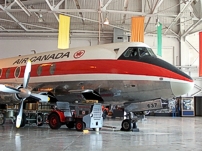
CF-THS at the Western Canada
Aviation Museum at Winnipeg, Canada.
In nineteen years TCA - Trans-Canada Air Lines Viscounts flew over one and a half million hours. The
fleet was never grounded, and never suffered a serious major accident. Even the delay rate wasn't too shabby.
Fortunately, the bulldozer hasn't levelled those 50 year old walls and roof. The hangar, or barn as it used to
be called, still stands, as the Western Canada Aviation Museum.
Today there stands Viscount No. 637, c/n 279 CF-THS complete with old tractor and baggage trolley. There's also
a big ugly Bristol Freighter there, as a reminder to those of us who used to twist wrenches in the early '50s.
The hangar walls don't echo to the sound of riveting guns, or the shine of feathering pumps anymore. The shop
walls don't rebound with the clicks of an inching control or the snap of an igniter box. Instead there are
visitors and children asking questions about airplanes much older than our beloved Viscount.
So, if you've ever worked at YWGMB, drop in and see the clean and tidy workplace. It will rekindle some
memories. If you can arrange a visit to the region, go there and catch the Winnipeg spirit - it lives on.
(Your co-pilot worked at P & S at Heathrow, London, England and, together with Wally Evans, well remembers
having to ship the spars and spares, and handling AOG demands - eds)
Phil Pawsey of TCA - Trans-Canada Air Lines admits to not keeping written note but reflects on
his days of classroom training on Viscount maintenance. He notes;
'We used to teach the most economical altitude to flight plan the Viscount which used to fall between the
fastest and least fuel altitude. If I remember correctly it used to be around 15,000 feet but varied with stage
length. It was a great aircraft and a joy to fly and ride in after the piston engine aircraft. One of the weak
points which caused the most in flight engine shutdowns was the high pressure fuel pump. I am sure that your
gentlemen who are involved in the Viscount project know that the pump with its rotating set of plungers with
slipper pads rubbing on the variable position plate had a high failure rate. Other engines with gear pumps
solved this problem.'
Pete Ettinger wrote in that he joined the Vickers Viscount Network because of his past ownership
and experience with the Viscount.
'We owned a 745D that was originally sold as one of three executive aircraft to U.S. Steel Corporation in
Washington DC. Ours was N907G c/n 185 and I will send you more information when I locate the files and photos.
Brian Burrage, the Vickers Viscount Network historian points out that N907G was actually a V.764D rather
than a V.745D which was the Capital Airlines model designation. He also says that any relevant
information that can be found in the files, along with any photos would be very much appreciated. 'We do not
have any interior shots of her at all.'
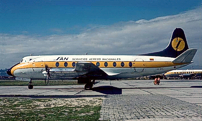
SAN - Servicios Aereos Nacionales
Viscount c/n 185 HC-BCL.
Pete continues; 'I know I have photos of the machine with the executive interior, twelve seats, and exterior
as well. We converted her to airline seating and sold her to SAN - Servicios Aereos Nacionales in Quito,
Ecuador. Captain Milo was flying her when it crashed going into Cuenca but I don't have the exact date
of the accident right now. Perhaps you know about the incident and more history of her. My father, Carl, and I
bought and sold used aircraft and purchased the Viscount from Codas in Monterrey, Mexico. We had the aircraft
in inventory much longer than we, or our bank, expected and when contacted by SAN we installed the airline
seats, purchased from Continental Airlines, Captain Malo and Coronel Ortega from Quito
flew her away from Albuquerque, New Mexico loaded with every sort of personal item they could purchase. It was
comical what they loaded in addition to many Vickers spares for the airline operation.'
Brian also notes 'As you can see from our website history, we have no information on the Codas ownership, so
anything that you can provide, such as actual dates would be fantastic. The aircraft crashed 4 September 1977,
so a very short time in service with SAN. Unusually for a commercial aircraft it was reportedly a VFR flight
in IMC conditions and struck a mountain on approach to Cuenca. Sadly all 33 on board were killed. Personal
recollections like Pete's are priceless to us.'
We emphasis that last line about personal recollections. If you are certain of particular facts you just might
have the answer to a query that has tormented someone else trying to solve it for years.
ELVIS AND THE VISCOUNT
Yeah, honestly! Ed Jones found this item on TCG - The Charter Group on the internet.
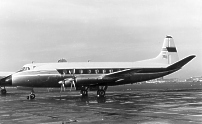
N905 was one of 3 Viscounts
purchased by TCG from the
US Steel Corporation.
The year was 1967 and the company was contemplating the formation of a commercial air charter operation, one
that would complement the company's existing government charter operation. A telephone call was received from
the International Hotel-Casino, now the Las Vegas Hilton, inquiring about a charter flight. A couple of hours
later the caller appeared at the company's office with the customer and arranged our first commercial air
charter. The customer was Vernon Presley, the father of Elvis, and the manager of the Presley
Family Enterprises.
Our company had just purchased a large and luxurious executive aircraft from US Steel Corporation and
stationed it at the company's hanger on McCarran International Airport. The aircraft had been the personal
aircraft of Roger Blough, then head of US Steel. It was beautiful and outfitted with a plush office and
conference area and luxurious living quarters, all furnished with the best of china, crystal, and decor.
Until then, the new commercial air charter division of the company was a virtual stealth operation. The
company did not have a commercial marketing department and had only one customer. Las Vegas was very small in
those days and the Presley account attracted other clients.
To read the full item, and you don't have to be an Elvis fan to appreciate it, visit
www.thechartergroupllc.com.
LATEST UPDATES
On-going work on ZK-BRF in Christchurch, New Zealand.
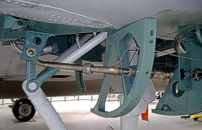
The starboard fuel inter-tank
valve after restoration on ZK-BRF.
Denys Jones, our man in Christchurch, has lately been working solidly on reinstating the internal
fittings of Viscount V.807 ZK-BRF. On our site have a look at [News] [Viscount Restoration News] [ZK-BRF c/n
283] for his detailed description of the work he has done recently supported by quality photographs to
illustrate the degree of difficulty. The quality of his workmanship is superb.
APPLYING INSULATION TO VISCOUNT SKIN
Stories abound from our Canadian friends. Here is another from the Air Canada NetLetter 317 adapted from
notes supplied by Bill Sim. It tells how the insulation was applied to the skin of the Viscount after
receiving them from England. Just the tonic for Viscount restorers after spending hours hidden away inside the
confines of a Viscount fuselage!
'I remember it well, the adhesive was red in colour, and I still believe that this was the same substance that
I used in the RAF for anti-corrosive treatment on metallic parts. We called this material 663. In the
RAF I was an MTM - Motor Transport Mechanic. While I was with 90 MU I was assigned to the anti-corrosive unit,
Warton (between Preston and Blackpool), England and had some very good nights at The Blackpool Tower!'
'I remember well, that to inspect the aircraft skin from the inside of the aircraft, we had to remove the fibre
glass insulation. As the English would say 'we build them, you maintain them', anyway it was a tough job with
lots of solvents around. It's a wonder we didn't blow the aircraft apart, one spark and the crew and the
aircraft would have been gone. We were a happy bunch singing and laughing enjoying the job. We did not know that
we were doped up from the solvents we were using, in those days we only smoked cigarettes'.
If my story is a little mixed up, we can blame it on some of the fumes that maybe are still in my system from
the old Viscount days in Winnipeg. Maybe you would like to check out how the carpet was stuck to the aircraft
floor, before double-sided adhesive tape, of course. This was all changed by the same guys, before the spar
job. I was there, Bill Sim.'
and yet another NetLetter, this time from Bob Troup who refers to the infamous Viscount wing . . .
'. . . a job we had to perform on the inside of the infamous Viscount wing. A small doubler had to be inserted
in an area above the wheel-well. The operation had to provide a 90% blueing contact with the parent surface,
and this required a Cat17 mechanic on top of the wing and another in a very constricted space above the landing
gear. There were only two of us in the shop who, for reasons of stature or lack of claustrophobia, qualified for
this operation. In the winter the one who lost the toss found himself squeezed into this tiny opening with his
lower extremities half frozen, while sweating bullets as he filed away, with the aid of a rather hot lamp inches
from his face. My compatriot in this unforgettable exercise was Charlie Pungent. Happy days? Bob
Troup.
MORE ON AIR CANADA
Bruce Trewin has alerted us to some nice Air Canada pictures. Have a look at
www.jeanpierrebonin.com/aviation/museumpages/AvionsMuseum-5-.htm.
AND AGAIN! THIS TIME IN PHOENIX ARIZONA.
Jack Stephens, the Vickers Viscount Network's Canadian researcher and former TCA - Trans-Canada Air
Lines employee who worked at the Winnipeg Overhaul Base during the time of the Vickers Viscounts has just
visited Phoenix, Arizona, USA.
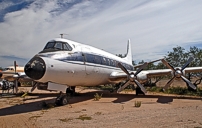
Viscount c/n 40 N22SN at the
Prima Air and Space Museum.
On the must see list is the former TCA - Trans-Canada Air Lines/Air Canada Viscount c/n 40 CF-TGI at
the Pima Air and Space Museum now carrying the registration N22SN. Before his departure to Arizona Jack
exchanged e-mails with the Curator, James Stemm who revealed the Museum's plans to repaint the aircraft
in its original TCA livery. James was quick to pounce on Jack to gain his expertise in the finer points on the
paint scheme. No doubt we will have a full report in due course on the visit. In the meantime go to their
website via the Vickers Viscount Network by going to [Links] [Organisations with complete Viscount
Airframes]. Then scroll down to the fourth illustrated Viscount. Of particular significance is that this
was the first Viscount to fly a revenue service in North America between Canada and the USA, way back in April
1955.
MODELLERS - A HELPFUL TIP
FOR BUILDERS OF UNITED AIRLINES MODELS
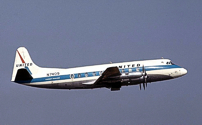
United Airlines Viscount
c/n 107 N7408.
In an exchange of messages between Vickers Viscount Network researchers Richard Stanton and
Peter Upton, Richard asked 'I'm looking to build the United Airlines Viscount V.745D N7405, this
being the aircraft that crashed near Newport, Tennessee in July 1964 after an in-flight cabin fire. I already
have the United Airlines S and M Models 1/96 decal sheet for the Glencoe kit which offers two Registration
alternatives, N7411 and N7457. I have however discovered that you can use Letraset black 'rub down' transfers
(Helvetica Medium Condensed 5mm high), which are virtually identical in size and appearance to those on the
decal sheet. Letraset state that these can also be applied to painted or plastic surfaces, (although I have
not tested this in practice). Therefore in theory it should be possible to build any Viscount V.745D example
that flew for United Airlines.'
Peter replied 'Having used it in a drawing office environment for many years, and on some personal projects, I
would advise that you seek a suitable sealer if you intend 'rubbing' it down onto paint or plastic. It tends to
crack and chip off after a while even on paper or tracing paper without a suitable spray sealer.'
'On paint or plastic I think you would have to experiment to avoid some sort of chemical reaction between the
paint and the sealer. I hope that doesn't sound too drastic, probably a clear lacquer would suffice.'
VISCOUNTS ALIVE!
In need of a nostalgia fix! Well, here is some footage which came Geoff Blampied's way recently. Note
there are several pages of clips and it is not all Viscounts, Careful - you can get addicted to these things!
http://video.google.com
NEW PAGES TO THE WEBSITE SINCE THE LAST NEWSLETTER
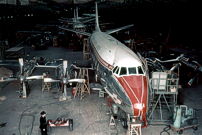
Viscount c/n 152 G-AOJC on the
production line at Weybridge, England.
The histories of Viscounts c/n 152, c/n 187, and c/n 213 have been update with new information. To view them, on
the site go to [Listings] [Aircraft Histories] then enter the [Construction Number] or
[Registration] of the aircraft that you are interested in, e.g. 152 or G-AOJC, then press [Go]
and you will be taken to the complete history of the aircraft selected.
Also there have been new photos added to the following aircraft:-
c/n 15, c/n 30, c/n 31, c/n 32, c/n 34, c/n 76, c/n 77, c/n 98, c/n 100, c/n 101, c/n 152, c/n 213, c/n 224,
c/n 244, c/n 258, c/n 356, c/n 414, and c/n 415.
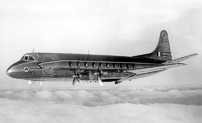
Aer Lingus Viscount
c/n 30 EI-AFV.
To see the photo gallery of an aircraft, on the site go to [Photos] [Viscount Photo Gallery]. Select the
[Construction Number] or [Registration] of the aircraft that you are interested in, e.g. 30 or
EI-AFV, then press [Go].
Note: Keep an eye on the right hand side red column of every page on the website for a list of the
latest 20 aircraft that have had photos added.
VISCOUNT CRASH MEMORIAL
Terry Bannon has contacted the Vickers Viscount Network regarding the tragic loss of BEA -
British European Airways Viscount c/n 63 G-ANHC. His father, James Bannon, was the radio operator
on its ill fated flight on 22 October 1958 when it collided with an Italian Air Force F-86E at 23,500
feet above Nettuno, near Anzio, Italy, during flight BE142 from Heathrow, London, England to Malta via Naples,
Italy. All 26 passengers and 5 crew died in the accident. The F-86 pilot from Practica di Mare airbase survived
after ejecting. Three other F-86s which were in the same formation landed safely.
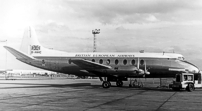
BEA - British European Airways
Viscount c/n 63 G-ANHC.
Terry reports, 'In October 2004 I visited Nettuno for the first time. I arranged through the Italian Embassy
in Dublin to meet the Mayor of Nettuno and he arranged for myself and my wife to visit the crash site. He also
arranged for two of fire crew, who attended the scene in 1958, to come with us. As you can imagine it was a
very emotional event for everyone especially the two Italian gentlemen who had not been there since the crash.'
'The area had not changed as the aircraft fell into a Italian Military Base and so our fears of maybe finding
a block of flats or a hotel on the site were not founded.'
'The commander of the base asked what could he do for us and I requested his permission to erect a memorial
there. He gave us permission provided I went through his Minister of Defence in Rome.'
'On returning to Ireland the first thing I did was enrol in an Italian class. Then I designed the monument. I
returned to Nettuno the following April (2005) and met the stone mason. It was unveiled in April 2006 by myself,
my brother Liam and my Dad's brother Bill, along with 20 other family members. We returned this year for the
50th anniversary and I presented plaques to the Mayor, the two firecrew and the commander of the base.'
'Despite notices in two English newspapers I have only been able to make contact with one family member of the
other deceased. Through my own detective work (internet) I traced Carol Foster the daughter of the Pilot,
Captain Frank Foster.'
'We hope to get a photograph of the plaque for readers to see and appreciate.'
Editor - Peter Layne's note:
'I have full appreciation of Terry's efforts in getting a plaque organised. The airline book writing
team in New Zealand, to which I belong, has taken charge of creating and erecting plaques at all fatal airliner
crash sites in New Zealand. We are all researchers. Graeme McConnell is a retired draughtsman and Rev.
Richard Waugh is Superintendent of the Wesleyan Methodist Church in New Zealand. Between us we have now put
in place such a plaque for all but one of the qualifying accident sites. The unveiling in front of grieving
families (50 years on in some cases) is a moving scene for all and brings that much needed closure for so many.
I put the challenge to you to give thought to following Terry's example.'
LIGHT HEARTED BUT TRUE VISCOUNT MOMENTS
Peter Layne
We didn't receive any this month so I will add a personal experience BUT DON'T TRY THIS AT HOME. Besides,
most of us don't have room for an Airbus A380!
Recently I flew from Heathrow to Singapore aboard Singapore Airlines. The A380 has built up a reputation
for quietness. During the last three or so hours of the flight, 9V-SKF, flew through ongoing buffeting. Not
being one to sleep on aircraft I noted that the old favourite 'Tora Tora Tora' was available. I've seen this
film several times, but with the added dimension of motion, those aerial scenes become so vivid. Turn the volume
up a bit so you can't hear the Airbus and it's better still!
IF YOU have a light hearted BUT TRUE Viscount moment to share, please send it to the Newsletter
Editors for consideration at
membership@vickersviscount.net.
Well that's it for the December issue and we hope that you've enjoyed it. Have a Merry Christmas and a Happy
New Year and we'll see you again in 2009.
Best regards
Peter Layne, Wellington, New Zealand, Ed Jones, Manchester, England and all the team at the
Vickers Viscount Network.
If you missed our first regular Newsletter, (July 2008), you can read it and all subsequent editions on our
website. Just go to [News] [Vickers Viscount Network Newsletters].
To provide information and photos for inclusion in the Virtual Museum please send them to
information@vickersviscount.net
Photos should be scanned as jpg's at 600 dpi or over. If you need help scanning your photos then contact
Brian Burrage at
brian.burrage@vickersviscount.net
who provides the Vickers Viscount Network quality, secure and FREE scanning service.
To add a friend or colleague to the Vickers Viscount Network membership, on the site go to [Home] [Join the
Vickers Viscount Network for free] [Click here to join the Vickers Viscount Network].
To cancel your membership to the Vickers Viscount Network send an e-mail to
membership@vickersviscount.net.
The Vickers Viscount Network team are all unpaid volunteers who work on this project around their
daytime jobs and family commitments.
Any opinions expressed in this publication are not necessarily those of the Vickers Viscount Network or
the Newsletter Editors.



